A black kitchen sink is a popular style choice for many households. If you have a black kitchen sink, you know that it can be a challenge to keep it looking clean and shiny. Black sinks are notoriously difficult to keep clean because any dirt or food particles show up very clearly. This article will give you some tips on how to clean your black kitchen sink and keep it looking its best!
Why Are Black Kitchen Sinks so Popular?
Black kitchen sinks are among the most popular choices for any kitchen renovation. This is because black adds a modern and sophisticated look to a kitchen while being highly resilient at the same time. Black is also very easy to keep clean since it doesn’t show streaks or water spots as easily as white or other lighter-colored materials. Furthermore, black stands out against light-colored countertops and cabinets, making it an ideal choice for adding visual interest to your kitchen design.
Also, black is highly resistant to staining and scratching, meaning that it won’t need replacing anytime soon. Finally, many people simply love the way it looks in their kitchen! All of this adds up to make black an incredibly popular option for any modern kitchen and bathroom. If you’re looking for an edgy and stylish look, black kitchen sinks are a perfect choice [1].

5 Steps to a Clean Black Composite Sink
Step 1: Keep Your Sink Dry
When not in use, keep your black composite sink dry by wiping it down with a soft cloth. This prevents water spots and helps maintain the finish of the sink.
Step 2: Clean With Mild Soap and Water
To clean your black composite sink daily, use warm water and mild soap or dish detergent. Use a non-abrasive sponge or cloth to gently scrub away any dirt or residue that has built up on the surface of the sink.
Step 3: Baking Soda Paste for Stubborn Stains
For tougher stains, make a baking soda paste using one part baking soda to two parts water. Apply this paste directly onto the stain and let it sit for about 15 minutes. Then, use a soft cloth to scrub the paste away.
Step 4: Use Vinegar for Sanitizing
To sanitize your sink and remove odors, pour one cup of white vinegar into the sink and let it sit for about 30 minutes. When finished, rinse the sink with warm water and wipe it down with a clean cloth.
Step 5: Periodically Polish Your Sink
Periodically polish your black composite sink with a non-abrasive cleaner designed specifically for sinks. Apply a small amount of the cleaner onto a soft cloth and gently rub it onto the surface of the sink in circular motions until polished to your desired shine. Wipe away any remaining residue with another soft cloth before rinsing the sink with warm water. Follow these steps and your black composite sink will look like new for years to come [2]!
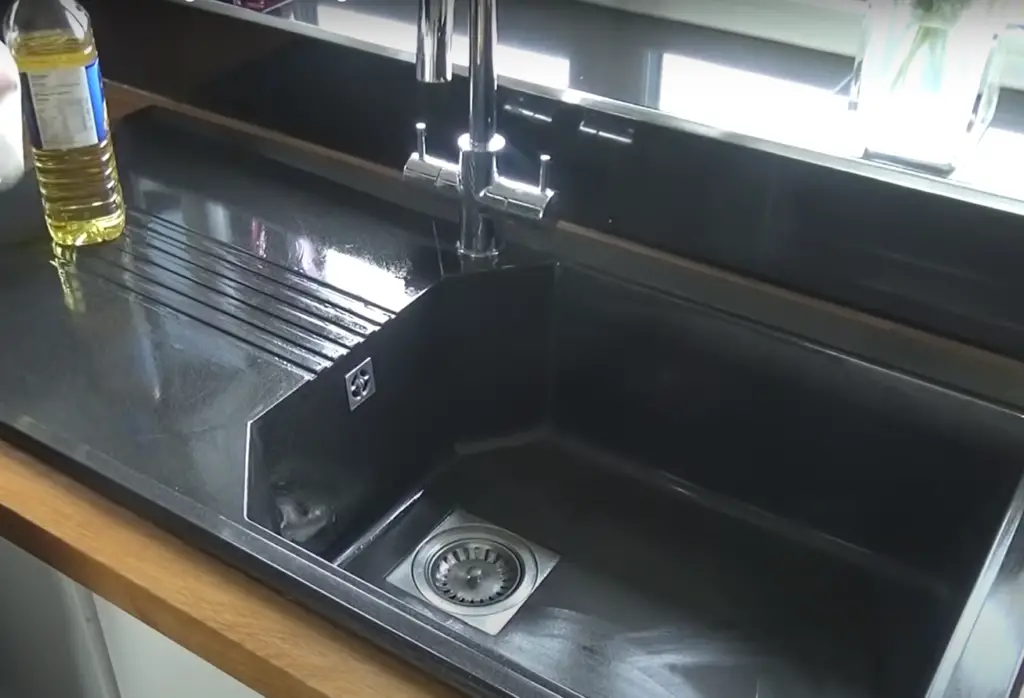
What to Avoid When Cleaning a Black Composite Sink?
Harsh Cleaners
It is important to avoid harsh cleansers when cleaning a black composite sink. Harsh cleansers contain abrasive ingredients that can cause damage to the surface of the sink and make it more prone to scratches and other types of wear and tear. For this reason, use gentle cleaners such as dish soap or mild detergent to clean your black composite sink.
Scrubbing Brushes
Do not use scrubbing brushes when cleaning a black composite sink because they can easily leave scratches on the surface. Instead, use a soft cloth or sponge to gently wipe away dirt and debris without causing any damage to its surface.
Limescale Removers
Limescale removers can damage the surface of a black composite sink so it is important to never use them. If you want to remove limescale, try using white vinegar or lemon juice to dissolve the mineral deposits without causing any harm.
Abrasive Cleaning Materials
Avoid using steel wool or scouring pads when cleaning a black composite sink as they can scratch the surface. It is best to use a soft cloth or sponge instead as they won’t cause any scratches on the sink’s surface.
Bleach
It is also important to avoid using bleach when cleaning a black composite sink as it can damage the finish of the material and make it look dull and fade over time. Stick to natural solutions such as white vinegar, lemon juice, or baking soda to clean your black composite sink without causing any harm [3].
How to Maintain Black Kitchen Sinks?
Maintaining black kitchen sinks is not as difficult as it may seem. To keep your black sink looking like new, there are a few simple steps you can take to ensure its longevity. The first step in taking care of your black kitchen sink is to make sure it’s clean and free of dirt and grime. Use a mild detergent with warm water and a soft cloth when cleaning the surface, and always avoid products that contain bleach or abrasive cleaners that could damage the surface. It’s also important to consider what type of materials you use when washing dishes. Avoid heavily soiled pans that might scratch the sink’s surface, and never use steel wool pads on your black kitchen sink.
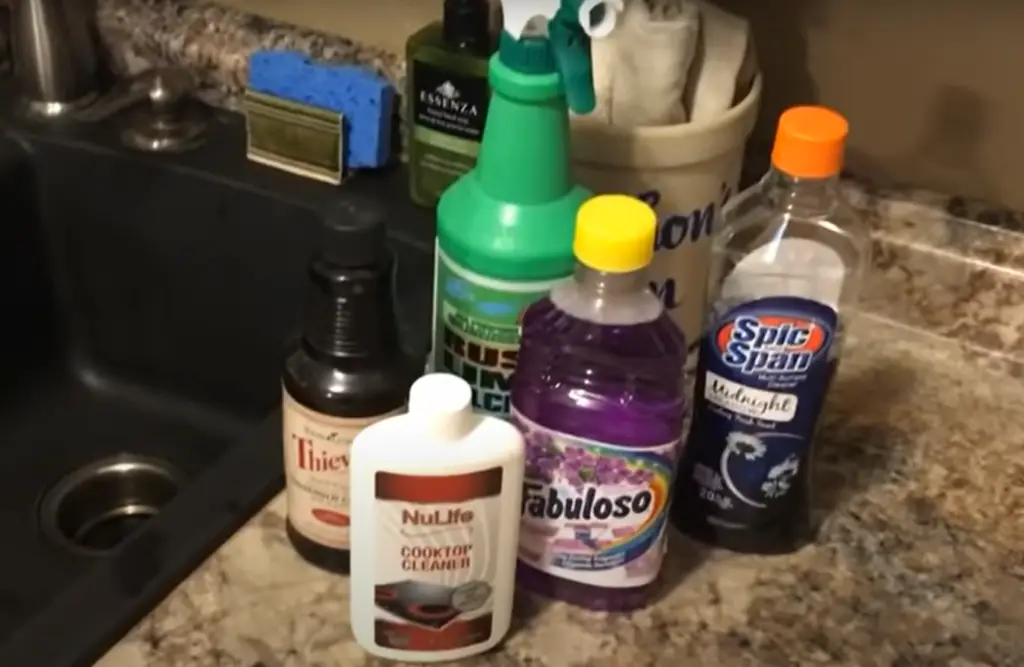
You should also make sure to protect the surface of your black kitchen sink from staining. This can be done by applying a thin layer of wax, sealant, or car wax to the finish of the sink. Doing this will help seal the surface and prevent staining from happening in the future. Additionally, it’s important to wipe down your sink after each use with a soft cloth that is dampened with warm water. Doing this will help keep your black kitchen sink looking its best for years to come!
What to Consider when Choosing the Black Kitchen Sink?
When selecting the perfect black kitchen sink for your home, there are several things to consider.
Consider if you’d like a single bowl or double bowl design, or if you need a specialized style such as one with an integrated drainboard or lower-level basin for preparing food and washing dishes. Second, it is important to consider the material that makes up your black kitchen sink. Different materials offer their advantages – stainless steel sinks can be extremely durable, while granite composite models require little maintenance and feature sound-dampening technology for a quieter kitchen.
Once you’ve narrowed down the type of material, consider other features such as the number of pre-drilled holes, thickness, and protective coating to ensure that your sink will last you a long time. The average thickness can be between 16-gauge and 18-gauge. Most kitchen sink models can be covered with such protection covers as enamel, acrylic, or granite.
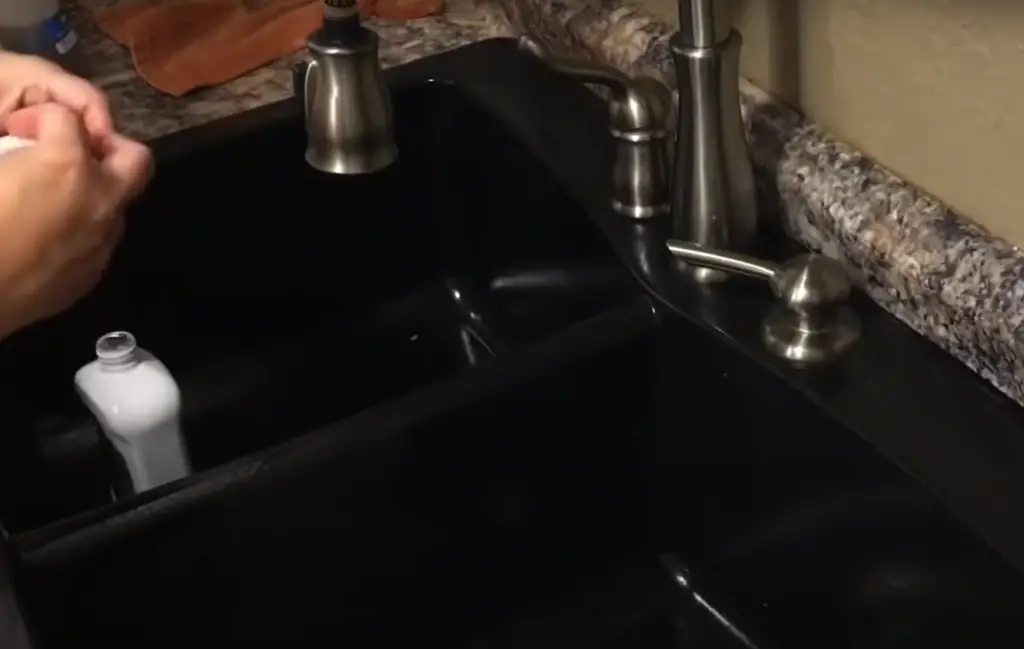
Always measure the space at least twice before buying to make sure the sink you select will fit in the desired kitchen area. This ensures that your new black kitchen sink not only looks great but also functions properly. Finally, consider the cost of installation and any potential accessories you may need such as faucets and strainers.
The average installation costs can range from $ 50 to upwards of $ 150. By taking into account the size, material, and cost of your black kitchen sink, you can find the perfect model for your home. With careful research and an understanding of your needs, you can be sure to get the best value for your money [4].
What Problems Can Occur with A Black Kitchen Sink?
- Staining: The biggest problem with a black kitchen sink is that it can easily become stained from regular use, especially if you are using harsh cleaning products to clean the surface. This is because darker colors, like black, tend to absorb more color than lighter shades and will show any staining more prominently. To prevent this, it’s important to wipe up spills as they happen and regularly scrub and rinse your sink with mild soap and warm water;
- Temperature Variance: Black sinks may also be susceptible to temperature variance which could cause warping or cracking over time. To avoid this, make sure you only use hot water when washing dishes and not cold or boiling temperatures that can damage the material of the sink;
- Corrosion: Black kitchen sinks can also be vulnerable to corrosion from acidic substances or harsh cleaners. To protect your sink, use a gentle cleaner and avoid using any abrasive materials that could scratch the surface of the sink. Additionally, make sure you rinse off any residue after cleaning to prevent it from eating away at the material over time;
- Scratches and Dents: Since black sinks are made out of various materials, they can be susceptible to scratches and dents if not handled properly. Be sure to use a cutting board when prepping food and avoid placing heavy pots or dishes in the sink as this could damage the surface;
- Fading: Over time, exposed sunlight may cause your black sink to fade. To prevent this, make sure you have adequate window coverings or use a cleaning product that contains UV protection to help keep your sink looking like new;
- Wear and Tear: Like any other kitchen fixture, regular use will eventually cause wear and tear on your black sink. Regularly inspect the surface for chips, cracks, stains, or discoloration so you can act quickly to repair any damage before it becomes too severe;
- Maintenance: Black sinks require more maintenance than other colors since they are prone to staining and fading over time. You should clean and rinse the sink regularly with mild soap and warm water and avoid using abrasive materials that could scratch the surface of the sink. Additionally, apply sealant or wax to protect the surface, and make sure to use only soft cloths when cleaning;
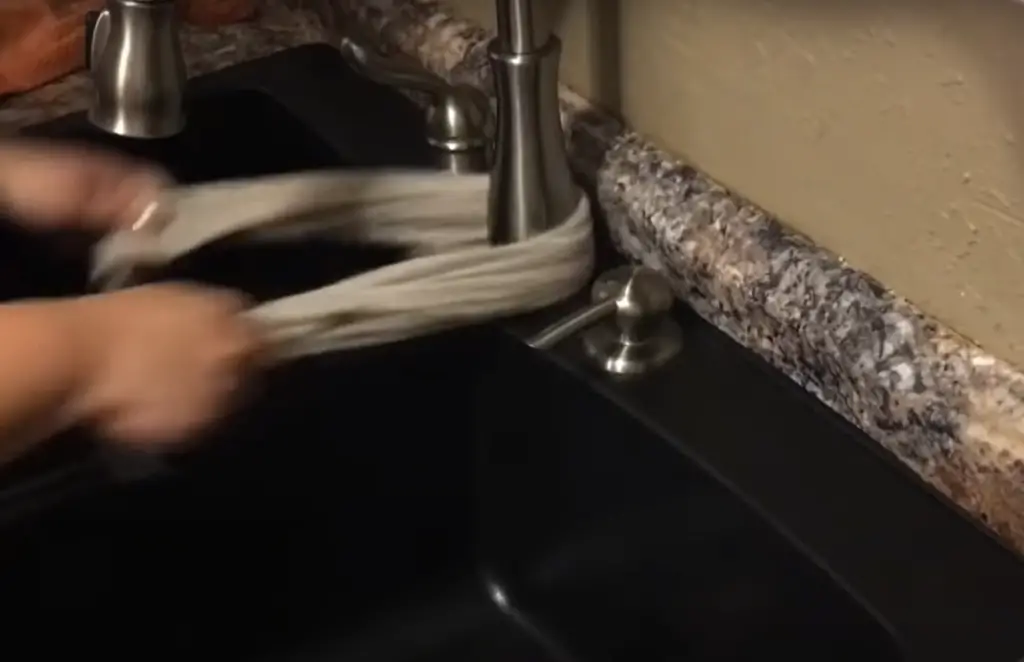
Overall, while black kitchen sinks can look beautiful in any space, they require more upkeep and maintenance than other sink materials. To ensure your sink looks as good as new for years to come, be sure to take extra care when cleaning and handle it with care. With a little bit of TLC, you should have no problems keeping your black kitchen sink looking great for years to come!
Cleaning a Black Kitchen Sink: Effective Methods and Maintenance
Maintaining the cleanliness of a black kitchen sink is essential for a polished look. Here’s a comparison of effective cleaning methods and tips for ongoing sink maintenance.
| Cleaning Method | Materials Needed | Maintenance Tips |
|---|---|---|
| Vinegar and Baking Soda | White vinegar, baking soda, soft cloth or sponge. | Regularly rinse the sink after use. Avoid leaving acidic foods or chemicals in the sink for extended periods. |
| Lemon and Salt | Lemon, table salt, soft cloth or sponge. | Prevent heavy staining by immediately rinsing and cleaning after preparing foods with strong colorants. |
| Commercial Sink Cleaner | Black sink cleaner product, soft cloth or sponge. | Reapply a protective sink guard or wax regularly to maintain the sink’s finish. |
| Olive Oil and Soap | Olive oil, mild dish soap, soft cloth or sponge. | Avoid abrasive cleaners or scouring pads that can damage the sink’s surface. |
| Hydrogen Peroxide and Water | Hydrogen peroxide, water, soft cloth or sponge. | Clean gently in the sink’s direction lines to avoid scratching the surface. |
Explanation of the table:
This table provides a comparison of various cleaning methods for black kitchen sinks, along with the required materials and maintenance tips. Keeping a black sink clean and well-maintained not only preserves its appearance but also prolongs its lifespan. Regular rinsing and appropriate cleaning methods help prevent stains and damage.
FAQ
How do I get my black sink back to black?
To get your black sink back to its original color, you can use a cleaning product that contains UV protection or apply sealant or wax to the surface. Additionally, make sure to clean and rinse your sink regularly and avoid using any abrasive materials when cleaning.
Can I use bleach on my black kitchen sink?
No, it is not recommended to use bleach on a black kitchen sink as it could corrode the surface over time. To keep your sink looking like new, mild soap and warm water is usually sufficient for most cleaning tasks. If necessary, you can also use a gentle cleaner designed for use on delicate surfaces.
How do I remove stains from my black kitchen sink?
Stains can be removed from a black kitchen sink with a mild abrasive cleaner or baking soda and water. Additionally, you can use products specifically designed for removing stains from sinks, such as oxalic acid. However, it’s important to read the instructions carefully before using any type of cleaner and always test it in an inconspicuous area before applying it to the entire surface.
How often should I clean my black kitchen sink?
It is recommended that you clean your black kitchen sink at least once a week to remove dirt and grime build-up. Make sure to rinse off any residue after cleaning and regularly scrub and rinse your sink with mild soap and warm water. Additionally, apply sealant or wax to protect the surface, and make sure to use only soft cloths when cleaning.
Does a black kitchen sink require special care?
Yes, black sinks are more susceptible to fading and staining than other materials so they do require special care. Make sure you have adequate window coverings to block out any direct sunlight and avoid using abrasive materials that could scratch the surface of the sink. Additionally, clean and rinse your sink regularly with mild soap and warm water and apply sealant or wax to protect the surface. With these extra steps, your black kitchen sink should remain looking like new for years to come!
Why is my black sink turning white?
White discoloration of a black kitchen sink is usually caused by the accumulation of hard water deposits. To keep your sink looking like new, regularly clean and rinse it with mild soap and warm water and use a soft cloth when cleaning. Additionally, you can apply sealant or wax to help protect the surface from staining. If needed, you can also use a cleaner specifically designed for removing hard water deposits. With regular care, your black kitchen sink should remain to look great for years to come!
Can I paint my black kitchen sink?
Yes, you can paint your black kitchen sink if desired. Make sure to prepare the surface properly beforehand by cleaning and sanding off any imperfections before applying a primer coat of paint. Additionally, use a paint suited for metal surfaces and make sure to let each coat dry before applying the next. With proper preparation and application of paint, your black kitchen sink should look as good as new in no time!
How do I get white marks off my black sink?
White marks on a black kitchen sink can be removed with a baking soda and water paste or mild abrasive cleaner. Additionally, you can use products specifically designed for removing stains from sinks, such as oxalic acid. Make sure to read the instructions carefully before using any type of cleaner and always test it in an inconspicuous area before applying it to the entire surface. With regular care and cleaning, your black kitchen sink should remain looking like new for years to come!
How do I keep my black sink shiny?
To keep your black kitchen sink looking shiny, regularly clean and rinse it with mild soap and warm water. Additionally, use a soft cloth when cleaning, apply sealant or wax to help protect the surface from staining, and avoid using abrasive materials that could scratch the surface of the sink.
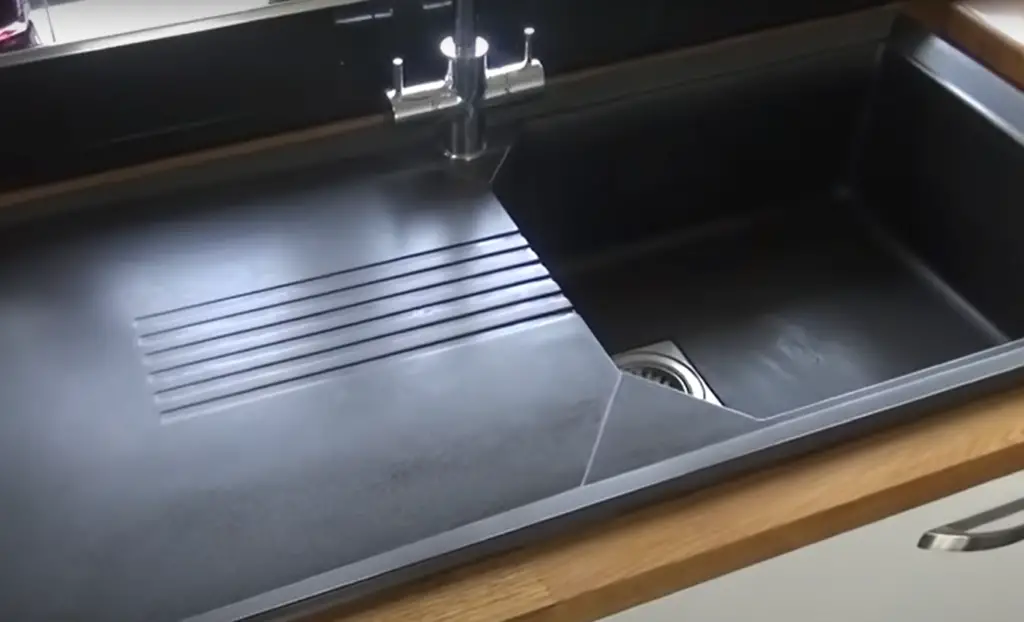
What is better: a white or black kitchen sink?
The best kitchen sink for you depends on your preferences and what type of look you are trying to achieve. White sinks tend to be popular because they can lend a classic, timeless feel to any space. Black sinks create a bolder statement and can make the space appear more modern. Ultimately, it comes down to personal preference so choose the one that suits your style and needs best!
How to install a kitchen sink?
Installing a kitchen sink requires some basic plumbing knowledge and the right tools. First, you’ll need to know how to correctly measure your new sink and select the appropriate size for your space. Then, install any necessary drainage pipes before connecting them to the sink drainpipe. Next, attach the faucet, water supply lines, and other fittings before placing the sink into position. Secure the sink with screws or clips before testing all of the connections to make sure they are working properly.
What are the best materials for the kitchen sink?
The best materials for kitchen sinks are stainless steel, acrylic, fireclay, and composite granite. Stainless steel is durable and easy to clean, but it can show fingerprints and watermarks easily. Acrylic is lightweight and available in a variety of colors, but it’s not as durable as some other materials. Fireclay is a type of ceramic material that offers a classic look but may require more maintenance since it’s prone to chips and scratches. Lastly, composite granite is a combination of quartz particles bound together with resin and pigment for strength, durability, and stain resistance. Ultimately the material you choose should depend on your budget, needs, and style preferences!
Can I use a magic eraser on a composite sink?
No, you should not use a magic eraser on a composite sink as it may scratch the surface or cause discoloration. Instead, try cleaning your sink with mild soap and warm water, making sure to rinse off any soap residue before drying with a soft cloth. Additionally, if your composite sink has stubborn marks or stains that won’t come clean with soapy water, you can use baking soda and water paste to gently scrub away any remaining residue.
What is the best way to clean and maintain a black kitchen sink to keep it looking its best?
To clean and maintain a black kitchen sink, regularly rinse it with warm soapy water and a soft cloth. For deeper cleaning, use a mixture of baking soda and water or a non-abrasive kitchen cleaner. Avoid abrasive pads or harsh chemicals to prevent damage.
How can I remove stubborn stains from a black kitchen sink effectively without damaging the finish?
Stubborn stains can be removed from a black kitchen sink by creating a paste of baking soda and water, applying it to the stained area, and gently scrubbing with a soft sponge or cloth. For tough stains, consider using a mixture of vinegar and water, but avoid harsh abrasives.
Are there any specific care tips to prevent the development of white marks or discoloration on a black sink?
To prevent white marks or discoloration on a black sink, avoid leaving metal pans or dishes in the sink for extended periods. Additionally, always rinse and wipe down the sink after use to remove any residual water or cleaning products that can lead to discoloration.
Is it safe to use bleach on a black kitchen sink, or are there alternative cleaning products recommended?
While bleach can be used to clean a black kitchen sink, it should be used sparingly and diluted with water. Alternative cleaning products like vinegar or baking soda are often recommended for regular cleaning, as they are less abrasive and can effectively clean the sink without harsh chemicals.
What should I avoid using or doing to maintain the appearance and finish of a black kitchen sink?
To maintain the appearance and finish of a black kitchen sink, avoid using abrasive pads or harsh scrubbers, as they can scratch the surface. Also, steer clear of harsh chemicals and strong acids that can damage the sink’s finish. Instead, opt for gentle cleaning methods and materials.
Useful Video: Cleaning, and maintaining, a granite composite sink
Conclusion
Cleaning a black kitchen sink isn’t as difficult as it seems. All you need is a few simple supplies, like baking soda and lemon juice, to keep your sink looking its best. Cleaning the black kitchen sink regularly will help extend its life and ensure that it remains free from bacteria, dirt, and grime for many years to come. With just a bit of regular maintenance, your black kitchen sink can look brand new for a long time. So don’t be afraid to break out the cleaning supplies and get scrubbing! You won’t regret it! Overall, with a little bit of effort and patience, you can easily keep your black kitchen sink sparkling clean and looking like new for years to come. By following these steps every month or so, you can guarantee your sink will stay clean and germ-free.
References:
- https://www.victorianplumbing.co.uk/bathroom-ideas-and-inspiration/black-kitchen-sinks-the-next-big-kitchen-trend
- https://www.wikihow.com/Clean-a-Black-Sink
- https://housegrail.com/clean-a-black-composite-sink/
- https://www.theplumbette.com.au/building-and-renovation/what-you-need-to-know-when-buying-a-black-kitchen-sink/














Leave a Reply